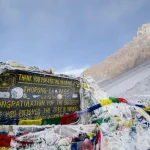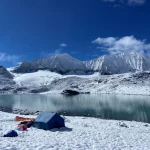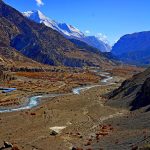Nepal, the land of the Himalayas, is much more than just a destination for trekking and mountaineering. It is a vibrant tapestry of ancient traditions, diverse cultures, and rich history, all intertwined with the spirit of the mountains. Whether you’re wandering through its bustling cities, visiting ancient temples, or interacting with its warm-hearted people, Nepal offers countless opportunities to experience its unique cultural heritage. In this article, we’ll explore some of the most enriching cultural experiences that will allow you to discover the heart and soul of Nepal.
- Festivals: A Colorful Celebration of Life
Nepal is known for its many festivals, which are deeply rooted in Hinduism and Buddhism but also celebrate the nation’s diverse ethnic groups and traditions. These festivals are often a mix of spiritual observance, cultural rituals, and festive revelry, making them one of the best ways to experience Nepal’s culture.
Dashain (The Nepali Dussehra)
Dashain is the most important Hindu festival in Nepal, similar to Dussehra in India. Celebrated for 15 days, it marks the victory of good over evil, symbolized by the goddess Durga’s triumph over the demon Mahishasura. Families reunite, perform religious ceremonies, and exchange blessings. The festival is also marked by the offering of sacrifices (usually animals) at temples, as well as the crowning of the eldest family member with tika (a mixture of yogurt, rice, and vermillion powder).
Tihar (Festival of Lights)
Tihar is another major festival celebrated with great enthusiasm, often called the “Festival of Lights” due to the beautiful display of oil lamps, candles, and lights in every household. It spans five days, each dedicated to a different animal, with special rituals honoring crows, dogs, cows, oxen, and finally, the goddess Lakshmi, the goddess of wealth. On the last day, people also celebrate brother-sister bonds with gifts and a special tika ceremony.
Buddha Jayanti
Celebrating the birth, enlightenment, and death of Siddhartha Gautama (Buddha), Buddha Jayanti is one of the most important religious holidays for Buddhists in Nepal. The day is marked by processions, prayers, and the lighting of butter lamps in temples such as Swayambhunath and Boudhanath. Visiting these stupas during Buddha Jayanti provides a profound insight into the Buddhist culture that permeates much of Nepal.
Indra Jatra
Held annually in Kathmandu, Indra Jatra is one of Nepal’s most iconic festivals. It honors Indra, the god of rain and harvest, and is celebrated with processions, mask dances, and the display of the living goddess (Kumari) in a chariot parade. The event also includes the famous “Kumari Jatra” and a grand display of chariots drawn by devotees.
- Temples and Sacred Sites: A Journey Through Nepal’s Spiritual Heart
Nepal is home to some of the most revered temples and sacred sites in the world. The country’s history is steeped in Hinduism and Buddhism, with temples, stupas, and shrines scattered throughout the land. These sacred spaces are not only places of worship but also hubs of cultural activity and devotion.
Kathmandu Valley: A Spiritual Hub
Kathmandu Valley is often referred to as the “City of Temples” due to its many religious structures. Among the most notable are:
Pashupatinath Temple: This sacred Hindu temple is dedicated to Lord Shiva and is one of the holiest sites for Hindus. It sits on the banks of the Bagmati River, where cremation rites are often carried out, symbolizing the cycle of life and death.
Swayambhunath (Monkey Temple): A UNESCO World Heritage Site, this Buddhist stupa is one of the most famous landmarks in Nepal. The stupa’s eyes gaze out in all four directions, symbolizing the Buddha’s omnipresence. The temple complex also hosts vibrant Tibetan Buddhist rituals.
Boudhanath Stupa: Another UNESCO World Heritage Site, Boudhanath is one of the largest stupas in the world and is a center for Tibetan Buddhism. Pilgrims can be seen walking around the stupa while chanting mantras and spinning prayer wheels.
Lumbini: Birthplace of Buddha
A visit to Lumbini, the birthplace of Siddhartha Gautama (Buddha), is an essential cultural experience. The serene environment, with its sacred gardens, monasteries, and the Maya Devi Temple, provides deep insight into the teachings of Buddhism. Pilgrims from all over the world come to Lumbini to meditate and reflect on Buddha’s teachings.
- Traditional Nepali Cuisine: A Taste of Culture
Nepali food is a blend of rich flavors, spices, and ingredients that reflect the diverse ethnic groups and regional influences of the country. Whether you’re in the high mountains or the lowland Terai, the cuisine offers something for every palate.
Dal Bhat: The Heart of Nepali Meals
Dal Bhat (lentil soup with rice) is the staple food of Nepal, consumed daily by many Nepali families. It’s usually served with a variety of side dishes, such as vegetables, pickles (achar), and curd (yogurt). The meal is balanced, nutritious, and often consumed twice a day, embodying the essence of Nepali home-cooked food.
Momo: Nepali Dumplings
Momo, Nepali-style dumplings filled with meat or vegetables, are an integral part of Nepali cuisine. They’re typically served with a spicy dipping sauce and are a favorite street food across Nepal. You can find them in almost every restaurant or small eatery, from bustling Kathmandu to the quieter hill towns.
Newar Cuisine: A Rich Culinary Tradition
The Newars of the Kathmandu Valley are known for their distinct and intricate food culture. Dishes like Yomari, a steamed dumpling filled with jaggery and sesame seeds, and Sukuti, dried and spiced meat, showcase the rich flavors of the Newar people. The Newars also celebrate many festivals with elaborate feasts, and experiencing this cuisine is an excellent way to connect with the local culture.
- Meeting the People: A Deep Dive into Nepali Hospitality
The Nepali people are renowned for their hospitality, friendliness, and warmth. Meeting locals and learning about their way of life can be one of the most enriching aspects of traveling in Nepal.
The Sherpas of the Himalayas
The Sherpas, an indigenous group from the mountainous regions of Nepal, are known for their mountaineering skills and unique Buddhist culture. Many Sherpas are employed as guides and porters on treks to Everest and other mountains, and their way of life is steeped in Tibetan Buddhist traditions. Spending time with Sherpa communities in places like Namche Bazaar or Dingboche allows you to learn about their history, culture, and spiritual beliefs.
Tharu Culture in Chitwan
In the southern Terai region of Nepal, the Tharu people offer a glimpse into a unique, indigenous culture. The Tharus have their own language, music, dance, and traditions. A visit to a Tharu village near Chitwan National Park provides an opportunity to experience their distinct lifestyle, including traditional mud houses, vibrant dances, and folk music.
Tibetan Influence in the North
In the northern regions of Nepal, particularly in places like Pokhara and the Annapurna region, you’ll find communities heavily influenced by Tibetan culture. Buddhist monasteries, colorful prayer flags, and the practice of Tibetan Buddhism are evident in daily life. The Tibetan influence is especially visible in the cuisine, art, and spiritual practices of these regions.
- Art and Handicrafts: A Legacy of Tradition
Nepali art is a blend of Hindu and Buddhist influences, with intricate wood carvings, metalwork, and Thangka paintings showcasing the country’s spiritual and artistic heritage.
Thangka Paintings: These traditional Buddhist scroll paintings often depict religious symbols, deities, and mandalas. They are meticulously created and are used for meditation and teaching.
Handmade Paper: Nepal is famous for its handmade paper, created from the bark of the lokta plant. This paper is used for everything from art prints to journals, and buying a piece of Nepali paper art makes for a beautiful and authentic souvenir.
Wood Carving and Metalwork: The temples and palaces of Kathmandu Valley are adorned with exquisite wood carvings and intricate metalwork. You can visit workshops where artisans create these masterpieces and even purchase hand-carved wooden sculptures and jewelry.
Conclusion: Nepal’s Cultural Heartbeat
Nepal’s cultural experiences are as diverse and awe-inspiring as the Himalayas themselves. From its vibrant festivals and sacred temples to its rich culinary traditions and warm-hearted people, Nepal offers a deep, immersive experience that connects you with the soul of the country. Whether you’re wandering the ancient streets of Kathmandu, exploring sacred Buddhist sites, or sharing a meal with a local family, Nepal invites you to step into a world where culture, history, and spirituality blend harmoniously. Exploring this cultural richness is one of the most rewarding ways to discover the true heart of the Himalayas.









Would love to travel bhutan someday.